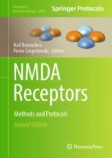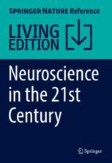Search
Search Results
-
Abolished ketamine effects on the spontaneous excitatory postsynaptic current of medial prefrontal cortex neurons in GluN2D knockout mice
Ketamine, a non-competitive antagonist of the N -methyl- d -aspartate receptor (NMDAR), generates a rapidly-acting antidepressant effect. It exerts...

-
Developmental up-regulation of NMDA receptors in the prefrontal cortex and hippocampus of mGlu5 receptor knock-out mice
mGlu5 metabotropic glutamate receptors are highly expressed and functional in the early postnatal life, and are known to positively modulate NMDA...

-
Expression and Purification of Mammalian NMDA Receptor Protein for Functional Characterization
N-methyl-D-aspartate (NMDA) receptors are critical for brain function and serve as drug targets for the treatment of neurological and psychiatric...
-
Characterizing Functional Contributions of Specific GluN2 Subunits to Individual Postsynaptic NMDAR Responses Using Biophysical Parameters
The NMDAR is a heterotetramer composed of two GluN1 subunits and two GluN2 and/or GluN3 subunits, with the GluN2 subunits exhibiting significant...
-
Conserved contributions of NMDA receptor subtypes to synaptic responses in lamina II spinal neurons across early postnatal development
NMDA receptors are heteromeric complexes that contribute to excitatory synaptic transmission and plasticity. The presence of specific variants of...

-
Selective Cell-Surface Expression of Triheteromeric NMDA Receptors
NMDA-type ionotropic glutamate receptors are critically involved in many brain functions and are implicated in a variety of brain disorders. Seven...
-
Glutamatergic Treatments for Parkinson’s Disease
Parkinson’s disease is characterized by the degeneration of dopaminergic neurons of the substantia nigra pars compacta (SNpc) projecting to the...
-
In the Telencephalon, GluN2C NMDA Receptor Subunit mRNA is Predominately Expressed in Glial Cells and GluN2D mRNA in Interneurons
N -methyl- d -aspartate receptors (NMDARs) are widely distributed in the brain with high concentrations in the telencephalon where they modulate...

-
Spectrum of NMDA Receptor Variants in Neurodevelopmental Disorders and Epilepsy
N-methyl-D-aspartate receptors (NMDAR) are ligand-gated ion channels mediating excitatory neurotransmission and are important for normal brain...
-
NMDA GluN2C/2D receptors contribute to synaptic regulation and plasticity in the anterior cingulate cortex of adult mice
IntroductionN-Methyl-D-aspartate receptors (NMDARs) play a critical role in different forms of plasticity in the central nervous system. NMDARs are...

-
African Naked Mole-Rats Demonstrate Extreme Tolerance to Hypoxia and Hypercapnia
Naked mole-rats are extremely tolerant to low concentrations of oxygen (hypoxia) and high concentrations of carbon dioxide (hypercapnia), which is...
-
Stellate Cells
Stellate cells are inhibitory GABAergic interneurons located in the molecular layer of the cerebellar cortex. Stellate cells receive excitatory...
-
Ionotropic Glutamate Receptors (and Their Role in Health and Disease)
On this planet, the mammalian brain is probably the most complex cellular network. In this system, glutamate is the dominant neurotransmitter, and it...
-
Ionotropic Glutamate Receptors (and Their Role in Health and Disease)
On this planet, the mammalian brain is probably the most complex cellular network. In this system, glutamate is the dominant neurotransmitter, and it...
-
Progresses in GluN2A-containing NMDA Receptors and their Selective Regulators
NMDA receptors play an important physiological role in regulating synaptic plasticity, learning and memory. GluN2A subunits are the most abundant...

-
MALDI imaging mass spectrometry: an emerging tool in neurology
Neurological disease and disorders remain a large public health threat. Thus, research to improve early detection and/or develop more effective...

-
Stellate Cells: Synaptic Processing and Plasticity
Stellate and basket cells in the molecular layer of the cerebellum are inhibitory interneurons that control the activity of Purkinje cells. Recent...
-
Enhancing Fear Extinction: Pharmacological Approaches
Extinction is the process by which the memory of a learned conditioned association decreases over time and with introduction of new associations. It...
-
Limb-Clas** Response in NMDA Receptor Palmitoylation-Deficient Mice
Proper regulation of N -methyl- d -aspartate-type glutamate receptor (NMDA receptor) expression is responsible for excitatory synaptic functions in the...

-
Adult Neural Plasticity in Naked Mole-Rats: Implications of Fossoriality, Longevity and Sociality on the Brain’s Capacity for Change
Naked mole-rats (Heterocephalus glaber) are small African rodents that have many unique behavioral and physiological adaptations well-suited for...
